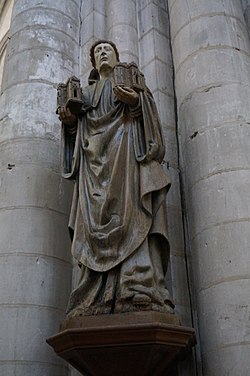This is an old revision of this page, as edited by 112.201.175.0 (talk) at 06:39, 17 April 2024 (→Cîteaux). The present address (URL) is a permanent link to this revision, which may differ significantly from the current revision.
Revision as of 06:39, 17 April 2024 by 112.201.175.0 (talk) (→Cîteaux)(diff) ← Previous revision | Latest revision (diff) | Newer revision → (diff) 11-century French saint| Saint Robert of Molesme | |
|---|---|
 Robert of Molesme, 15th century statue Robert of Molesme, 15th century statue | |
| Born | 1028 Troyes, County of Champagne, Kingdom of France |
| Died | 17 April 1111(1111-04-17) (aged 82–83) Molesme, Kingdom of France |
| Venerated in | Catholic Church |
| Canonized | 1222 by Pope Honorius III |
| Feast | January 26 (initially April 17, subsequently April 29) |
Robert of Molesme (1028 – 17 April 1111) was an abbot, and a founder of the Cistercian Order. He is venerated as a Christian saint.
Life
Robert was born about 1029 near Troyes, a younger son of Thierry and Ermengarde, nobles of Champagne. He entered the Benedictine abbey of Montier-la-Celle near Troyes at age fifteen and rose to the office of prior.
He was made abbot of Saint Michel-de-Tonnerre around the year 1070, but he soon discovered that the monks were quarrelsome and disobedient, so he returned to Montier-la-Celle.
Meanwhile, two hermits from a group of monks that had settled at Collan went to Rome and asked Pope Gregory VII to give them Robert as their superior. The pope granted their request, and as of 1074 Robert served as their leader. Soon after, Robert moved the small community to Molesme in the valley of Langres in Burgundy. Initially, the establishment consisted of only huts made of branches surrounding a chapel in the forest, dedicated to the Holy Trinity. Molesme Abbey quickly became known for its piety and sanctity, and Robert's reputation as a saintly man grew. It is because of this renown that in 1082, Bruno of Cologne came to Robert seeking advice. He lived with Robert's community for a time before going on to found the Grande Chartreuse, the first Carthusian monastery.
In 1098, there were 35 dependent priories of Molesme, other annexes, and some houses of nuns. Donors from the surrounding area vied with one another in helping the monks who soon they had more than they needed, and slackened their way of life and became tepid. Benefactors sent their children to the abbey for education and other non-monastic activities began to dominate daily life. The vast land holdings they had acquired needed a large number of employees. As the community grew increasingly wealthy, it began to attract men seeking entry for the wrong reasons. They caused a division among the brothers, challenging Robert's severity. Robert twice tried to leave Molesme but was ordered back by the Pope.
Cîteaux

In 1098, Robert and twenty-one of his monks left Molesme with the intention of never returning. Renaud, the Viscount of Beaune, gave this group a desolate valley in a deep forest where they founded Cîteaux Abbey. Stephen Harding and Alberic – two of Robert's monks from Molesme – were pivotal in founding the new house. Hugh of Die, Archbishop of Lyons, was persuaded that they could not subsist there without endorsement from an influential churchman, so he wrote in their favour to Odo I, Duke of Burgundy. Odo paid for the construction they had begun, helping the monks finance their operating expenses and giving them much land and cattle. The Bishop of Challons elevated the new monastery to the canonical status of an abbey.
In 1099, the monks of Molesme asked Robert to return and agreed to submit entirely to his interpretation of the Rule of Saint Benedict; the local bishop also pressured Robert to return. He agreed, and Molesme became a major center for the Benedictines under his tutelage. Albéric was made his successor as abbot at Cîteaux, with Stephen Harding as prior.
Robert died on 17 April 1111, and Pope Honorius III canonized him in 1222. His feast day in the Roman Catholic Church is also on 17 April, with the Benedictines celebrating him, along with Alberic of Cîteaux and Stephen Harding on February 26.
The Vie de saint Robert de Molesme was written by Guy, his immediate successor as abbot of Molesme.
References
- ^ "Staley, Tony. "Robert of Molesme wanted a rigorous monastic life", The Compass News, Diocese of Green Bay, Wisconsin, April 24, 2010". Archived from the original on November 18, 2021. Retrieved November 18, 2021.
- Maurists (1900). Acta Sanctorum. Vol. April 3. pp. 676–683.
{{cite book}}: CS1 maint: location (link) CS1 maint: location missing publisher (link) - ^ Gildas, Marie. "St. Robert of Molesme." The Catholic Encyclopedia. Vol. 13. New York: Robert Appleton Company, 1912. 30 Mar. 2015
- ^ Butler, Alban. "St. Robert, Abbot of Molesme, Founder of the Cistercians", The Lives of the Saints, Vol.IV, 1866
- Deborah Vess. "Brief Introduction to the Cistercians". Georgia College & State University. Archived from the original on 2000-08-26.
- Britannica, The Editors of Encyclopaedia. "St. Robert of Molesme". Encyclopedia Britannica
- Martyrologium Romanum (in Latin) (2 ed.). Administrationem Patrimonii Sedis Apostolicae in Civitate Vaticana. 2004. p. 239.
- Proper Masses for the Use of the Benedictine Confederation. Collegeville, Minnesota: The Liturgical Press. 1975. p. 9.
![]() This article incorporates text from a publication now in the public domain: Herbermann, Charles, ed. (1913). "St. Robert of Molesme". Catholic Encyclopedia. New York: Robert Appleton Company.
This article incorporates text from a publication now in the public domain: Herbermann, Charles, ed. (1913). "St. Robert of Molesme". Catholic Encyclopedia. New York: Robert Appleton Company.